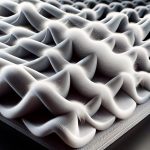To safely steam clean your upholstery, start by gathering your steam cleaner, vacuum, and microfiber cloth. Check your fabric’s care label to choose the right steam setting. Always test steam on a hidden spot first to avoid damage. Clean in small sections using short steam bursts, wiping with a cloth afterward. Let the upholstery dry fully in a well-ventilated space. Follow these steps, and you’ll keep your furniture fresh while protecting its fabric. There’s more to guarantee the best results ahead.
Table of Contents
Key Takeaways
- Inspect fabric type and care labels to select appropriate steam settings and avoid damage.
- Fill the steam cleaner with distilled water and test on a hidden area for colorfastness.
- Clean in small sections using short steam bursts, followed by blotting with a microfiber cloth.
- Use low to medium steam intensity based on fabric delicacy, avoiding over-saturation.
- Allow upholstery to dry fully with good ventilation, avoiding direct sunlight to prevent fading.
Gather the Necessary Tools and Materials
Before you begin steam cleaning your upholstery, gather all the necessary tools and materials to guarantee a smooth process. You’ll need a reliable steam cleaner designed for upholstery, with adjustable settings to prevent fabric damage.
Grab a vacuum cleaner with an upholstery attachment to remove loose dirt first. Have a clean microfiber cloth or sponge handy to blot excess moisture. Prepare a spray bottle filled with distilled water to help loosen stains if needed.
Keep a soft-bristle brush nearby for stubborn spots, but avoid anything abrasive. Don’t forget gloves to protect your hands and assure proper ventilation in the area.
Having everything ready means you’ll work efficiently without interruptions, making your upholstery look fresh and clean in no time.
Inspect the Upholstery Fabric and Check Care Labels
Before you start steaming, take a close look at your upholstery fabric to identify its type.
Make sure to read the care labels carefully, as they provide essential cleaning instructions.
Following these guidelines will help you avoid damaging the fabric during cleaning.
Identify Fabric Type
How do you know which steam cleaning method suits your upholstery best? First, you need to identify the fabric type. This step guarantees you avoid damage and achieve the best results.
Here’s how to identify your upholstery fabric:
- Look closely at the texture—is it smooth, coarse, or woven?
- Check for natural fibers like cotton or wool, which handle steam differently than synthetics.
- Note synthetic fabrics such as polyester or nylon, which often tolerate steam well.
- Consider blends, as they may require gentler cleaning.
Understand Care Instructions
Although you’ve identified the fabric type, you still need to inspect the upholstery closely and check its care labels to understand the recommended cleaning methods. Look for symbols and instructions that indicate whether steam cleaning is safe or if alternative methods are advised. Ignoring these can damage your furniture.
Here’s a quick guide to common care label symbols:
| Symbol | Meaning |
|---|---|
| W | Use water-based cleaners |
| S | Use solvent-based cleaners |
| WS | Water or solvent cleaners |
| X | No water or solvent |
| Triangle | Bleach allowed |
Prepare the Steam Cleaner for Upholstery Use
Before you start, choose the right steam setting for your upholstery fabric to avoid damage.
Next, fill the water tank with clean water, making sure not to overfill it.
Finally, test the steam cleaner briefly to guarantee it’s working properly and producing consistent steam.
Select Appropriate Steam Settings
Choosing the right steam setting is essential to avoid damaging your upholstery while achieving a deep clean. Different fabrics require different steam intensities, so adjust your cleaner accordingly. Here’s how to select the appropriate settings:
- Check your upholstery label for fabric type and cleaning codes.
- Set low steam for delicate materials like silk or velvet to prevent shrinkage or burns.
- Use medium steam for common fabrics such as cotton or polyester for effective cleaning without damage.
- Avoid high steam settings on any upholstery unless specified as safe, as excessive heat can cause color fading or fabric weakening.
Fill and Test Water Tank
Start by filling the steam cleaner’s water tank with clean, distilled water to prevent mineral buildup.
Avoid tap water since minerals can clog the machine and reduce its lifespan.
Use a funnel if needed to avoid spills. Fill the tank up to the indicated maximum level, but never overfill it.
Once filled, securely close the tank lid to prevent leaks during use.
Next, plug in and turn on the steam cleaner, allowing it to heat up fully.
You’ll usually see a light or hear a beep indicating it’s ready.
Test the steam output briefly by pressing the trigger or button over a sink or safe surface.
This guarantees steam flows correctly and the machine is ready for effective upholstery cleaning.
Perform a Spot Test on a Hidden Area
Since upholstery materials can react differently to cleaning methods, you’ll want to perform a spot test on a hidden area to verify the steam cleaner won’t cause damage or discoloration. This simple step protects your furniture and guarantees safe cleaning.
Follow these steps to perform the spot test:
- Locate a discreet area, like the underside of a cushion or behind the armrest.
- Apply a small amount of steam from your cleaner to the spot.
- Wait at least 10 minutes to observe any changes in color, texture, or fabric integrity.
- If no damage or discoloration occurs, you’re good to proceed with steam cleaning the rest of the upholstery.
This quick test saves you from potential costly mistakes.
Steam Clean the Upholstery in Small Sections
Once you’ve confirmed the upholstery can handle steam cleaning, focus on working in small sections. This approach guarantees even cleaning and prevents overwetting the fabric.
Start by pressing the steam cleaner nozzle gently against the fabric, moving it slowly over a 12-inch by 12-inch area. Keep the nozzle moving to avoid saturating one spot. Use short bursts of steam and follow up immediately with the attached brush or cloth to lift dirt and moisture.
After finishing one section, move to the next adjacent area, slightly overlapping to maintain consistency. This method helps you control moisture levels and allows you to address stubborn stains more effectively.
Allow the Fabric to Dry Completely
Although steam cleaning removes dirt effectively, you’ll need to let the upholstery dry completely before using it again. This step is essential to prevent mold, mildew, and odors.
Allow upholstery to fully dry after steam cleaning to avoid mold, mildew, and unpleasant odors.
To speed up drying and guarantee thorough moisture removal, follow these tips:
- Open windows and doors to improve air circulation.
- Use fans directed at the upholstery to increase airflow.
- Avoid direct sunlight, which can cause fabric fading or damage.
- Allow at least 4-6 hours for drying, depending on the fabric and room humidity.
Never rush this process; sitting or placing objects on damp upholstery can cause stains or damage.
Patience guarantees your furniture stays fresh, clean, and in great condition after steam cleaning.
Maintain Upholstery After Steam Cleaning
To keep your upholstery looking its best after steam cleaning, you’ll want to follow a few simple maintenance steps.
First, vacuum regularly to prevent dust and dirt from settling deep into the fabric. Use a soft brush attachment to avoid damaging the fibers.
Next, promptly address spills with a clean cloth to prevent stains from setting in. Avoid exposing your upholstery to direct sunlight for long periods, as it can fade the fabric.
Rotate cushions frequently to promote even wear and maintain shape.
Finally, schedule regular steam cleaning sessions depending on usage—typically every 6 to 12 months—to keep your furniture fresh and hygienic.
Following these steps will extend the life of your upholstery and keep it looking clean and vibrant.
Frequently Asked Questions
Can Steam Cleaning Remove Pet Odors From Upholstery?
Yes, you can remove pet odors from upholstery with steam cleaning. It penetrates deep, killing bacteria and lifting stains. Just make sure you don’t over-wet the fabric, and let it dry thoroughly afterward.
Is Steam Cleaning Safe for Leather Furniture?
Think of leather as a delicate flower—too much steam can wilt it. You shouldn’t steam clean leather furniture directly; instead, use a damp cloth and conditioner to keep it soft and safe from damage.
How Often Should I Professionally Steam Clean Upholstery?
You should professionally steam clean your upholstery every 12 to 18 months, depending on usage and pets. Regular cleaning keeps fabrics fresh, removes allergens, and extends furniture life, so don’t skip this important maintenance step.
Can Steam Cleaning Help With Dust Mite Allergies?
Yes, steam cleaning can help with dust mite allergies by killing dust mites and removing allergens from your upholstery. You’ll reduce allergen buildup, making your home healthier and more comfortable for allergy sufferers.
What Are the Environmental Benefits of Steam Cleaning Upholstery?
You’ll reduce chemical use, saving water and energy with steam cleaning. It naturally kills bacteria and dust mites, making your home healthier while minimizing environmental pollution—an eco-friendly choice for fresh, clean upholstery without harsh cleaners.
- The Best Staple Guns for Upholstery: A 2024 Review - July 8, 2025
- The Best Pet-Friendly and Cat-Proof Upholstery Fabrics - July 8, 2025
- The Most Durable Upholstery Fabrics for High-Traffic Homes - July 8, 2025







